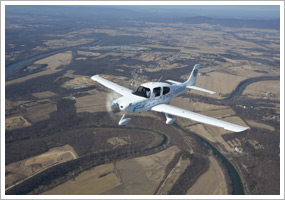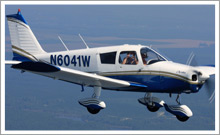| ||||
| | FT News | INSIDE AOPA | TRAINING PRODUCTS | FINAL EXAM | |||
TRAINING TIPsWinter flying, ‘hot’ airspace Under what condition, if any, may pilots fly through a restricted area? A) When flying on airways with an ATC clearance. B) With the controlling agency's authorization. C) Regulations do not allow this. Not sure of the answer? It’s better to research the matter during a ground planning session than when airborne. It can be daunting for a student pilot to unfold a sectional aeronautical chart and behold complexes of special-use airspace along a cross-country route. The most common are military operations areas (MOAs). You may know from your ground school studies that there is no prohibition on entering an MOA—although it’s a good idea to get a thorough briefing on whether the area will be “hot” when you get there, as discussed in the “ Training Tip: Operating around MOAs.” Restricted areas are another common type of special-use airspace. But these blocks of airspace may be off limits to general aviation aircraft when active. Times and altitudes of use, and the air traffic control facility (controlling agency) with jurisdiction over restricted airspace are listed on the side panels of your sectional chart. Restricted areas are discussed and a chart depiction illustrated in the Air Safety Institute’s Safety Advisor Airspace for Everyone . The institute’s interactive course Know Before You Go has lots of other great information as well. Here is a definition of restricted airspace from AOPA’s ABCs of Aviation glossary: “Airspace which (when "Active" or "Hot") usually excludes civilian aircraft. Examples: airspace for rocket flights, practice air-to-air combat or ground-based artillery practice. Temporary restricted areas are established for events such as forest fires, natural disasters or major news stories. Flight through a restricted area may be authorized by the ‘controlling agency’ or by FAA.” Note that a restricted area may not appear on your chart if established temporarily as described above. In any case, be sure to confirm that published information about a restricted area is accurate before a proposed flight. AOPA has long pressed for real-time information being available to pilots about special-use airspace activity. The National Transportation Safety Board shares AOPA’s concerns and has called for improved real-time information being provided. Study the resources given here on “hot” airspace and you will unhesitatingly choose Answer B to the sample question posed above.YOUR PARTNER IN TRAININGAviation resolutionChances are you have a new resolution already assigned to the new year. But what about an aviation resolution? Maybe it’s to fly more. But money is probably tight after the holidays. Think about jumping into a simulator. For an overview read this Flight Training story from September 2009. Simulator applications can be found in the most recent issue of Flight Training. To get even more tips, check out this story from early 2009. With tools like simulators, there’s no reason not to fly more in 2011.
Did you know that student pilots who join AOPA are three times more likely to complete their flight training? Membership includes unlimited access to aviation information by phone (800/USA-AOPA, weekdays from 8:30 a.m. to 6 p.m. Eastern time) or from Flight Training Online or AOPA Online. If you're not already a member, join today and get the pilot’s edge. Login information is available online. FLIGHT TRAINING NEWSOwn a piece of space historyMost people who love airplanes love anything that escapes Earth's grasp, including spaceflight. Those who grew up watching America's trips to the moon, and fantasizing about the adventure, can now experience a small piece of it. An auction company in New Hampshire is offering up more than 500 items from the race to the moon, including Gus Grissom's good luck piece, the headset worn by official capsule communicator Charlie Duke, and more. Check out the auction's website for more information. Lakeland College adds aviation programLakeland College in Sheboygan, Wis., has added a four-year aviation program. Working in a partnership with Frontline Aviation, the program will accept students beginning in the fall. Flight training will take place at Sheboygan County Memorial Airport. For more information, see the website. AFIT unveils new websiteAccelerated Flight and Instrument Training (AFIT) launched a newly redesigned website on Dec. 29. Known for its accelerated instrument training program, the company earlier this year announced the addition of a two-week private pilot program. AFIT is headquartered in Newport Beach, Calif., but has instructors around the nation. WSI: Talking about the weatherNothing meets the description of "a mixed bag" better than a winter aviation weather forecast. Icing, turbulence, strong winds, and wind shear associated with the more southerly, lower seasonal location of the jet stream in the atmosphere all can influence in-flight conditions or the essential go/no-go decision. Clear, calm winter days demand just as much care. So, what's the outlook for this winter? Andover, Mass.-based Weather Services International (WSI) recently released a seasonal forecast that heralds a season with La Niña exerting its influence. Read more >> Inside AOPALift the cowling with ‘Engine and Propeller’ courseHave you ever wondered what you don’t know about what’s going on under that cowling? Sure, the engine may purr when you start it, but what if it begins to run rough? An understanding of engine and propeller operations can help cure your curiosity, teach you a thing or two about how things work, and minimize dangerous wear and costly repair to the engine and prop. This course qualifies for AOPA Accident Forgiveness and the FAA Wings program. Take the course >> Experience the four-step cycleMost piston aircraft engines develop power using a four-step cycle—intake, compression, combustion, and exhaust. But what if the engine runs rough during cruise? The Air Safety Institute’s Engine Operations Safety Brief provides you in-depth systems knowledge and strategies needed to assess the engine’s actual condition. Download it now >> AOPA member keeps flying with AOPA’s helpKen Field has been a pilot since he was a teenager. Now as vice president of engineering for a large company, his flying is almost exclusively for business purposes. When a medical condition prompted the FAA to require Field to undergo much additional testing, he went along with it, thinking he would cooperate with the requirements. A friend mentioned AOPA’s Medical Services Program to him, suggesting he should take advantage of it. “I decided to get AOPA involved to help me find out the status of my paperwork with the FAA. I didn’t know how to go about doing that,” Field said. Read more >> TRAINING PRODUCTS‘The Savvy Flight Instructor’ available for KindleThe Savvy Flight Instructor: Secrets of the Successful CFI is available as an e-book for the Kindle. Written by Flight Training Contributing Editor Greg Brown, The Savvy Flight Instructor teaches tips and strategies for recruiting new and return flight students, increasing students’ skills and customer satisfaction for individual flight instructors as well as for flight schools and managers. Download it for $9.99 from Amazon. Note: Products listed have not been evaluated by ePilot editors unless otherwise noted. AOPA assumes no responsibility for products or services listed or for claims or actions by manufacturers or vendors. FINAL EXAMQuestion: I recently took a pre-solo written exam. One of the questions was about whether student pilots are required to carry their logbooks during solo flights. I was told it is a requirement; however I have not been able to find a regulation for it. Can you tell me what regulation addresses this issue?
Answer: As a student pilot, you are required to have your logbook with you for all of your solo cross-country flights, but not for every solo flight. According to FAR Part 61.51(i)(2), Presentation of Required Documents, a student pilot must carry the following items in the aircraft on all solo cross-country flights as evidence of the required authorized instructor clearances and endorsements: pilot logbook, student pilot certificate, and “any other record required by this section.” So, if you are just making a few trips around the pattern or perfecting maneuvers in the practice area, there is no requirement to have your logbook with you. For more information on logbooks and logging time, read AOPA’s subject report.
Got a question for our technical services staff? E-mail [email protected] or call the Pilot Information Center, 800/872-2672. Don’t forget the online archive of “Final Exam” questions and answers, searchable by keyword or topic. What's New OnlineSecurity at commercial airportsGeneral aviation pilots may be more security-minded than ever before, but at least they don’t have to endure what professional pilots do. Read one pilot’s perspective of the new security procedures on the Flight Training blog this week. AOPA Career OpportunitiesEver dream of turning your passion for aviation into a career? We're looking for a vice president of new product development and interactive marketing, business analyst, financial analyst, and IT project architect. To learn more about other AOPA career opportunities, visit AOPA Online. Picture Perfect
AVIATION EVENTS & WEATHER To include an event or to search all events in the calendar, visit AOPA Online. For airport details, including FBO fuel prices, see AOPA Airports. Flight Instructor Refresher ClinicsThe next Air Safety Institute Flight Instructor Refresher Clinics are scheduled in Jackson, Miss., and Portland, Ore., Jan. 15 and 16; Baltimore, Md., Detroit, Mich., and Charlotte, N.C., Jan. 22 and 23; San Jose, Calif., Sevierville, Tenn., and Bellevue, Wash., Jan. 29 and 30; Sacramento, Calif., Louisville, Ky., New Orleans, La., and Fairfax, Va., Feb. 12 and 13. For a complete schedule, see AOPA Online.
Can’t make it in person? Sign up for the CFI Refresher Online. Air Safety Institute Safety SeminarsAir Safety Institute Safety Seminars are scheduled in Mesa, Ariz., and Reno, Nev., Jan. 10; Tucson, Ariz., and Sacramento, Calif., Jan. 11; Milpitas, Calif., Jan. 12; Santa Rosa, Calif., Jan. 13; San Diego, Calif., and Fort Worth, Texas, Jan. 24; Costa Mesa, Calif., and Houston, Texas, Jan. 25; Ontario, Calif., and San Antonio, Texas, Jan. 26; Austin, Texas, Jan. 27; Little Rock, Ark., Jan. 31. Topics vary—for details and a complete schedule, see AOPA Online. | Advertisers Got news? Contact ePilot. Having difficulty using this service? Visit the ePilot Frequently Asked Questions now at AOPA Online or write to [email protected]. |
| Member Tools : Send feedback | ePilot Archive Editorial Team: ePilot Flight Training Editor : Jill W. Tallman | ePilot Editor: Sarah Brown | Contributor: Alton K. Marsh |

 A sample question from the
A sample question from the 
